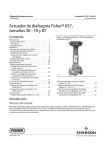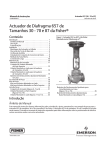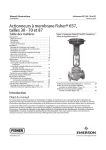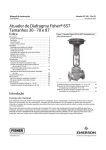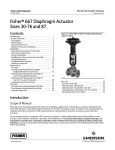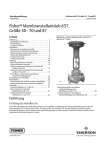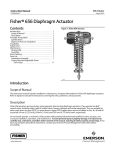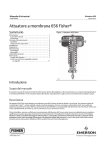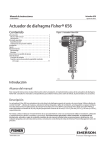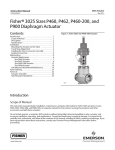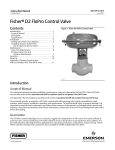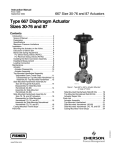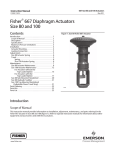Download Emerson Process Management FISHER 657 User's Manual
Transcript
Instruction Manual Form 1900 February 2007 657 Actuator (30-70 and 87) Type 657 Diaphragm Actuator Sizes 30-70 and 87 Contents Introduction . . . . . . . . . . . . . . . . . . . . . . . . . . . . . . . 1 Scope of Manual . . . . . . . . . . . . . . . . . . . . . . . . . 1 Description . . . . . . . . . . . . . . . . . . . . . . . . . . . . . . 2 Specifications . . . . . . . . . . . . . . . . . . . . . . . . . . . . 2 Installation . . . . . . . . . . . . . . . . . . . . . . . . . . . . . . . . 3 Mounting the Actuator on the Valve . . . . . . . . . 4 Discussion of Bench Set . . . . . . . . . . . . . . . . . . . 5 Spring Verification . . . . . . . . . . . . . . . . . . . . . . . . 5 Installing the Stem Connector Assembly . . . . . 6 Deadband Measurement . . . . . . . . . . . . . . . . . . 6 Loading Connection . . . . . . . . . . . . . . . . . . . . . . . 8 Maintenance . . . . . . . . . . . . . . . . . . . . . . . . . . . . . . 8 Actuator Maintenance . . . . . . . . . . . . . . . . . . . . . 8 Top-Mounted Handwheel Assembly . . . . . . . . 10 Side-Mounted Handwheel for Sizes 34 through 60 Actuators . . . . . . . . . . . . . . . . . . 11 Side-Mounted Handwheel for Sizes 70 and 87 Actuators . . . . . . . . . . . . . . . . . . . . . . 12 Casing-Mounted Adjustable Travel Stops . . . 14 Parts Ordering . . . . . . . . . . . . . . . . . . . . . . . . . . . . 15 Parts Kits . . . . . . . . . . . . . . . . . . . . . . . . . . . . . . . . 17 Kits for Side-Mounted Handwheels . . . . . . . . . 17 Kits for Top-Mounted Handwheels . . . . . . . . . 17 Parts List . . . . . . . . . . . . . . . . . . . . . . . . . . . . . . . . 17 Actuator Assembly (figures 6, 7, or 8) . . . . . . 17 Top-Mounted Handwheel (figures 9 or 10) . . 18 Side-Mounted Handwheel (figure 11 or 13) . . 18 Casing-Mounted Adjustable Up Travel Stops (figures 14 or 15) . . . . . . . . . . . . . . . . . . . . . . 22 Casing-Mounted Adjustable Down Travel Stops (figure 16) . . . . . . . . . . . . . . . . . . . . . . . . . . . . 23 Introduction Scope of Manual Figure 1. Type 657 or 657-4 Actuator Mounted on an easy-eR Valve through 70 and size 87. The Type 657-4 actuator in sizes 70 and 87 is also covered. Refer to separate instruction manuals for information about the valve positioner and other accessories used with these actuators. Do not install, operate, or maintain a Type 657 actuator without first D being fully trained and qualified in valve, actuator, and accessory installation, operation, and maintenance, and D carefully reading and understanding the contents of this manual. If you have any questions about these instructions, contact your Emerson Process Managementt sales office before proceeding. D100306X012 This instruction manual provides information on installation, adjustment, maintenance, and parts ordering for the Type 657 actuator in sizes 30 W2174-2/IL www.Fisher.com Instruction Manual Form 1900 February 2007 657 Actuator (30-70 and 87) Table 1. Specifications ACTUATOR SIZE SPECIFICATION(1) Nominal Effective Area Yoke Boss Diameters Acceptable Valve Stem Diameters Maximum Allowable Output Thrust(4) Maximum Travel(2) 30 34 40 45 46 50 60 70(1) 87(1) cm2 297 445 445 677 1006 677 1006 1419 1419 Inch2 46 69 69 105 156 105 156 220 220 mm 54 54 71 71 71 90 90 90 127 Inches 2-1/8 2-1/8 2-13/16 2-13/16 2-13/16 3-9/16 3-9/16 3-9/16 5 mm 9.5 9.5 12.7 12.7 12.7 19.1 19.1 19.1 25.4 Inches 3/8 3/8 1/2 1/2 1/2 3/4 3/4 3/4 1 N 10230 10230 12010 25131 33582 25131 30246 39142 39142 Lb 2300 2300 2700 5650 7550 5650 6800 8800 8800 mm 19 29 38 51 51 51 51 76(3) 76(3) 3(3) Inches 0.75 1.125 1.5 2 2 2 2 3(3) Maximum Casing Pressure for Actuator Sizing(4) Bar 8.6 4.5 4.5 3.4 2.8 3.4 2.8 3.8 3.8 Psig 125 65 65 50 40 50 40 55 55 Maximum Diaphragm Casing Pressure(4)(5) Bar 9.6 5.2 5.2 4.1 3.4 4.1 3.4 4.5 4.5 Psig 140 75 75 60 50 60 50 65 65 Material Temperature Capabilities _C Nitrile Elastomers: –40 to 82_C, Silicone Elastomers: –54 to 149_C, Fluorocarbons: –18 to 149_C _F Nitrile Elastomers: –40 to 180_F, Silicone Elastomers: –65 to 300_F, Fluorocarbons: 0 to 300_F Pressure Connections (female) 1/4 In. NPT X X X X X X X --- 1/2 In. NPT --- --- --- --- --- --- --- X X kg 16 22 23 37 49 42 53 107 116 Lb 36 48 51 82 107 92 116 235 255 Approximate Weights --- 1. These values also apply to the Type 657-4 actuator construction. 2. Actuator travel may be less than the value listed after connecting the actuator to the valve. 3. Maximum travel for Type 657-4 is 102 mm (4 inches). 4. Normal operating diaphragm pressure must not exceed maximum diaphragm casing pressure and must not produce a force on the actuator stem greater than the maximum allowable output thrust or the maximum allowable valve stem load. Contact your Emerson Process Management sales office with questions concerning maximum allowable valve stem load. 5. This maximum casing pressure is not to be used for normal operating pressure. Its purpose is to allow for typical regulator supply settings and/or relief valve tolerances. Note Neither Emerson, Emerson Process Management, nor any of their affiliated entities assumes responsibility for the selection, use and maintenance of any product. Responsibility for the selection, use, and maintenance of any product remains with the purchaser and end-user. Description The Type 657 actuator (figure 1) and the Type 657-4 actuator are direct-acting, spring-opposed diaphragm actuators. They provide automatic operation of control valve body assemblies. The Type 657 actuator offers 76 mm (3 inches) maximum actuator travel. The Type 657-4 actuator provides 102 mm (4 inches) maximum actuator travel. Both actuators position the valve plug in response to varying pneumatic loading pressure on the actuator diaphragm. Figure 2 shows the operation of these actuators. A Type 657 or 657-4 actuator can be equipped with either a top-mounted or a side-mounted handwheel 2 assembly. A top-mounted handwheel assembly is used as an adjustable up travel stop to limit actuator travel in the up direction (see figure 2). A side-mounted handwheel assembly is usually used as an auxiliary manual actuator. Adjustable casing-mounted up or down travel stops are also available for this actuator. Note If repeated or daily manual operation is expected, the actuator should be equipped with a side-mounted handwheel rather than a casing-mounted travel stop or top-mounted handwheel. The side-mounted handwheel is designed for more frequent use as a manual operator. Specifications Refer to table 1 for Specifications of the Type 657 and 657-4 actuators. See the actuator nameplate for specific information about your actuator. Instruction Manual Form 1900 February 2007 657 Actuator (30-70 and 87) AIR PUSHES STEM DOWN NPT FEMALE CONNECTION DIAPHRAGM CASING SPRING LIFTS STEM UP DIAPHRAGM AND STEM SHOWN IN UP POSITION DIAPHRAGM PLATE LOWER DIAPHRAGM CASING STEM ACTUATOR SPRING ACTUATOR STEM AF3833-A A0792-2/IL Figure 2. Schematic of Type 657 and 657-4 Actuators SPRING SEAT SPRING ADJUSTOR STEM CONNECTOR YOKE Installation TRAVEL INDICATOR DISK Key number locations are shown in figures 6, 7, and 8, unless otherwise indicated. Also, refer to figure 3 for location of parts. INDICATOR SCALE W0363–1/IL WARNING VALVE STEM Always wear protective gloves, clothing, and eyewear when performing any installation operations to avoid personal injury. Check with your process or safety engineer for any additional measures that must be taken to protect against process media. If installing into an existing application, also refer to the WARNING at the beginning of the Maintenance section in this instruction manual. CAUTION To avoid parts damage, do not use an operating pressure that exceeds the Maximum Diaphragm Casing Pressure (table 1) or produces a force on the actuator stem greater than the Maximum Allowable Output Thrust (table 1) or the maximum allowable valve stem load. (Contact your Emerson Process Management sales office with questions concerning maximum allowable valve stem load.) YOKE LOCK NUT MATCH LINE FOR ACTUATOR YOKE BOSS DIAMETER BONNET TYPICAL VALVE (REFER TO VALVE MANUAL) W6199–1/IL Figure 3. Actuator Mounting Components for Size 30 through 70 Actuators D Valve/Actuator Assembly: If the actuator and valve are shipped together as a control valve assembly, it has been adjusted at the factory, and may be installed in the pipeline. After installing the valve in the pipeline, refer to the Loading Connection procedures. D Actuator Mounting: If the actuator is shipped separately or the actuator has been removed from the valve, it is necessary to mount the actuator on the valve before placing the valve in the pipeline. Refer to the actuator mounting procedures before placing the valve in service. You may perform the Bench Set Spring Adjustment procedures in this 3 Instruction Manual Form 1900 February 2007 657 Actuator (30-70 and 87) SPRING ADJUSTER RATED VALVE TRAVEL MEASURE LOWER BENCH SET LOADING PRESSURE 1 ACTUATOR STEM UPPER BENCH SET PRESSURE MARK 3 VALVE STEM 4 MARK VALVE STEM HERE 3 2 UPPER BENCH SET LOADING PRESSURE NOTES: 1 THE LOWER PSIG LOADING PRESSURE (MARKED ON NAMEPLATE) WHERE THE FIRST MOVEMENT OF ACTUATOR STEM IS DETECTED. 2 THE UPPER PSIG LOADING PRESSURE EXTEND ACTUATOR STEM. 3 MARK THIS POINT WITH TAPE OR A MARKER. 4 MEASURE DISTANCE OF TRAVEL. IT SHOULD EQUAL THE TRAVEL SPAN SHOWN ON THE TRAVEL INDICATOR SCALE. 40A8715–B B2426 / IL Figure 4. Bench Set Adjustment section to confirm that the adjustment has not changed since it was shipped from the factory. D Positioner: If a positioner is installed, or is to be installed on the actuator, refer to the positioner instruction manual for installation. During the adjustment procedures, it will be necessary to provide a temporary loading pressure to the actuator diaphragm. Mounting the Actuator on the Valve The Type 657 actuator spring loading pushes the actuator stem up towards the actuator diaphragm (see figure 2). This spring action moves the stem away from the valve while installing the actuator. valve body), away from the actuator while mounting. Provide a temporary method of applying diaphragm loading pressure to the diaphragm to extend the actuator stem during bench set spring adjustments. 1. Provide a vise or some other method of supporting the valve and the weight of the actuator during assembly. For direct or reverse acting valves, push the valve stem down away from the actuator while mounting the actuator. 2. Screw the stem locknuts all the way onto the valve stem. With the concave side of the travel indicator disk (key 14) facing the valve, install the travel indicator disk on the valve stem. (Note: The travel indicator disk is not used with size 87 actuators.) 3. Lift or hoist the actuator onto the valve bonnet: CAUTION If the valve stem is allowed to remain in the up position (towards the actuator) during mounting, it can interfere with the actuator mounting, possibly damage valve stem threads or bend the valve stem. Be sure the valve stem is pushed down (into the 4 a. For size 87 actuators, insert the cap screws and tighten the hex nuts, securing the actuator to the bonnet. b. For all other size actuators, screw the yoke locknut onto the valve bonnet and tighten the locknut. (Note: On small size actuators, it may be necessary to remove the indicator disk and re-install it while lowering the actuator on to the Instruction Manual Form 1900 February 2007 657 Actuator (30-70 and 87) valve because the disk will not go through the actuator yoke opening). 4. Do not connect the actuator stem to the valve stem at this time. Whenever the actuator is installed on the valve, it is recommended to perform the Bench Set Spring Adjustment procedure to verify that the actuator is still adjusted correctly. Discussion of Bench Set The bench set pressure range is used to adjust the initial compression of the actuator spring with the valve-actuator assembly “on the bench.” The correct initial compression is important for the proper functioning of the valve-actuator assembly when it is put into service and the proper actuator diaphragm operating pressure is applied. The bench set range is established with the assumption that there is no packing friction. When attempting to adjust the spring in the field, it is very difficult to ensure that there is no friction being applied by “loose” packing. Accurate adjustment to the bench set range can be made during the actuator mounting process by making the adjustment before the actuator is connected to the valve (see the Spring Verification Procedure). If you are attempting to adjust the bench set range after the actuator is connected to the valve and the packing tightened, you must take friction into account. Make the spring adjustment such that full actuator travel occurs at the bench set range (a) plus the friction force divided by the effective diaphragm area with increasing diaphragm pressure or (b) minus the friction force divided by the effective diaphragm area with decreasing diaphragm pressure. For an assembled valve-actuator assembly, the valve friction may be determined by following the procedure described below: 1. Install a pressure gauge in the actuator loading pressure line that connects to the actuator diaphragm casing. Note Steps 2 and 4 require that you read and record the pressure shown on the pressure gauge. 2. Increase the actuator diaphragm pressure and read the diaphragm pressure as the actuator reaches its mid-travel position. 3. Increase the actuator diaphragm pressure until the actuator is at a travel position greater than its mid-travel position. 4. Decrease the actuator diaphragm pressure and read the diaphragm pressure as the actuator reaches its mid-travel position. The difference between the two diaphragm pressure readings is the change in the diaphragm pressure required to overcome the friction forces in the two directions of travel. 5. Calculate the actual friction force: Friction Force, = 0.5 pounds Difference in pressure readings, psig Effective diaphragm area, inches2 Refer to table 1 for the effective diaphragm area. When determining valve friction, you can make diaphragm pressure readings at a travel position other than mid-travel if you desire. If you take readings at zero or at the full travel position, take extra care to ensure that the readings are taken when the travel just begins or just stops at the position selected. It is difficult to rotate the spring adjustor (key 12, figure 6, 7, and 8) when the full actuator loading pressure is applied to the actuator. Release the actuator loading pressure before adjusting. Then re-apply loading pressure to check the adjustment. Spring Verification Ensure that the actuator stem is at the top of its travel as shown in figure 4 and not connected to the valve. (Note: Some spring compression is required to move the diaphragm to the top of its travel.) The bench set steps provided are the same for direct or reverse acting valves. WARNING When moving the actuator stem with diaphragm loading pressure, use caution to keep hands and tools out of the actuator stem travel path. Personal injury and/or property damage is possible if something is caught between the actuator stem and other control valve assembly parts. Also, provide a certified pressure gauge suitable to accurately read the diaphragm pressure from 0 through the upper bench set pressure marked on the 5 Instruction Manual Form 1900 February 2007 657 Actuator (30-70 and 87) nameplate. Apply loading pressure to the diaphragm. selection for your application. Or, contact your Emerson Process Management sales office for assistance. After replacing the spring, repeat the steps above. CAUTION Stroke the actuator a few times to ensure that the pressure gauge is working correctly, and that the actuator is functioning properly. To prevent product damage, it is important to be sure that the actuator assembly is not binding or producing any loading friction on the actuator stem movement. 1. If not already accomplished, provide a temporary means of applying an adjustable loading pressure to the actuator during bench set adjustments. 2. Set the diaphragm loading pressure at 0 psig. Then, slowly raise the pressure from 0 psig towards the lower bench set pressure while checking for the first movement of the actuator stem. The actuator stem should show movement at the lower bench set pressure. If movement occurs before or after the lower pressure is reached, adjust the spring adjuster (see figure 4) into or out of the yoke until the actuator stem’s movement is first detected at the lower bench set pressure. 3. Be sure the spring adjuster is adjusted to meet the requirements of step 2 above. 4. Apply the upper bench set loading pressure to the diaphragm. This pressure extends the actuator stem down towards the valve. (Note: the actuator stem may slide over the valve stem as shown in figure 4.) At the end of the actuator stem, use a marker or a piece of tape to mark the valve stem (see figure 4). (Note: If the actuator stem does not pass over the valve stem, provide a method to mark this point of stem travel.). 5. Slowly decrease the diaphragm loading pressure until the lower bench set pressure is applied. Measure the distance between the marker or tape on the valve stem to the end of the actuator stem. The distance should match the travel span shown on the travel indicator scale (key 18). If the span of travel is correct, bench set is complete. Proceed to the Installing the Stem Connector Assembly subsection. 6. If the travel span is not correct, a wrong or damaged spring has been installed in the actuator. To obtain the correct spring sizing information, refer to Catalog 14, Actuator Sizing and Sample Calculation sections to determine the correct spring 6 Installing the Stem Connector Assembly When installing the stem connector assembly (key 26), the actuator and valve stem threads should engage the threads of the stem connector by the distance of the diameter of the stem. Note Replacement stem connectors are an assembly of two stem connector halves, cap screws, and a spacer between the connector halves. Remove the spacer and discard, if present, before clamping the actuator and valve stems together. 1. If necessary, push the valve stem down so that it is touching the seat ring on direct acting valves. For reverse acting valves, push the stem down to the open position. If necessary, screw the valve stem locknuts down, away from the connector location. For all actuators except size 87, ensure that the travel indicator disk (key 14) is located on top of the locknuts. 2. Slowly increase the diaphragm pressure to the upper bench set pressure. This should be the same pressure used in the bench set steps, and it is marked on the nameplate. 3. Place the stem connector half with the threaded holes, approximately half way between the actuator and valve stems. Refer to figures 6, 7, and 8 to help locate the connector position. Be sure that the actuator and valve stem threads are engaging the threads of the stem connector by the distance of one diameter of the stem. CAUTION Incomplete engagement of either the valve stem or actuator stem in the stem connector can result in stripped threads or improper operation. Be sure that the length of each stem clamped in the stem connector is equal to or greater than one diameter of that stem. Damage to threads on either stem or in the stem connector can cause the parts to be replaced prematurely. Instruction Manual 1.0 0.6 9 LOWER BENCH SET PRESSURE RANGE OF DEADBAND OPENING VALVE 3 1 0.2 0 UPPER BENCH SET 15 PRESSURE OPENING VALVE 1.0 0.6 9 LOWER BENCH SET PRESSURE 3 RANGE OF DEADBAND CLOSING VALVE 1 DIAPHRAGM PRESSURE, BAR CLOSING VALVE UPPER BENCH SET 15 PRESSURE DIAPHRAGM PRESSURE, PSIG 657 Actuator (30-70 and 87) DIAPHRAGM PRESSURE, BAR DIAPHRAGM PRESSURE, PSIG Form 1900 February 2007 0.2 0 OPEN MID RANGE CLOSED CLOSED MID RANGE VALVE TRAVEL OPEN VALVE TRAVEL DIRECT ACTING VALVE REVERSE ACTING VALVE NOTE: 1 DEADBAND IS CAUSED BY FRICTION. A6763-2 / IL Figure 5. Typical Valve Response to Deadband 4. Install the other half of the stem connector and insert the cap screws and tighten them. If installing a positioner, also attach the feedback bracket at the same time. 5. Screw the valve stem locknuts up until the indicator disk contacts the bottom of the stem connector, or for size 87 actuators, the stem connector. Do not overtighten the locknuts. 6. Slowly decrease and then increase pressure several times stroking the valve from the lower bench set pressure to the upper pressure. Be sure that the valve is in closed position (up or down, depending on valve action). Loosen the screws on the travel scale, and align it with the travel indicator disk or stem connector. Stroke the valve full travel to ensure that the travel matches the valve travel on the travel indicator plate. If valve travel is not correct, repeat the stem connector procedure. Note For push-down-to-close valves, the valve plug seat is the limit for downward travel and the actuator up-stop is the limit for upward (away from the valve) movement. For push-down-to-open valves, the actuator down stop is the limit for downward movement, and the valve seat is the limit for upward (away from the valve) movement. Deadband Measurement Deadband is caused by packing friction, unbalanced forces, and other factors in the control valve assembly. Deadband is the range a measured signal can vary without initiating a response from the actuator (see figure 5). Each actuator spring has a fixed spring rate (force). You have verified that the right spring was installed in the actuator by completing the Bench Set Spring Adjustment steps. Deadband is one factor that affects the control valve assembly operation during automatic loop control. The control loop tolerance for deadband varies widely depending on the loop response. Some common symptoms of the deadband being too wide are no movement, a “jump” movement, or oscillating movements of the actuator during automatic loop control. The following steps are provided to determine the span of deadband. The percent of deadband is helpful in troubleshooting problems with the process control loop. 1. Start at a pressure near the lower bench set pressure, slowly increase pressure until the valve is approximately at mid-travel. Note this pressure reading. 2. Slowly decrease pressure until movement of the valve stem is detected, and note this pressure. 3. The difference between these two pressures is deadband, in psi. 7 Instruction Manual Form 1900 February 2007 657 Actuator (30-70 and 87) 4. Calculate the percent of deadband by: Deadband, psi Deadband = —————————————— = nn% Bench Set Span, psi Loading Connection The loading pressure connections are made at the factory if the valve, actuator, and positioner come as a unit. Keep the length of tubing or piping as short as possible to avoid transmission lag in the control signal. If a volume booster, valve positioner or other accessory is used, be sure that it is properly connected to the actuator. Refer to the positioner instruction manual or other manuals as necessary. For actuators shipped separately or whenever the actuator pressure connections are installed, use the following steps: 1. Connect the loading pressure piping to the NPT female connection in the top of the diaphragm casing. 2. For sizes 70 and 87 actuators, if necessary, remove the 1/4 inch NPT bushing if a 1/2 inch NPT female connection is needed to increase connection size. The connection can be made with either piping or tubing. 3. Cycle the actuator several times to be sure that the valve stem travel is correct when the correct pressure ranges are applied to the diaphragm. WARNING If valve stem travel appears to be incorrect, refer to the Bench Set Spring Adjustment procedures at the beginning of this section. To avoid personal injury or product damage, do not place the valve into service if it is not reacting correctly to diaphragm loading pressure changes. WARNING Avoid personal injury or property damage from sudden release of process pressure or bursting of parts. Before performing any maintenance operations: D Always wear protective gloves, clothing, and eyewear when performing any maintenance operations to avoid personal injury. D Disconnect any operating lines providing air pressure, electric power, or a control signal to the actuator. Be sure the actuator cannot suddenly open or close the valve. D Use bypass valves or completely shut off the process to isolate the valve from process pressure. Relieve process pressure from both sides of the valve. Drain the process media from both sides of the valve. D Vent the power actuator loading pressure and relieve any actuator spring precompression. D Use lock-out procedures to be sure that the above measures stay in effect while you work on the equipment. D The valve packing box may contain process fluids that are pressurized, even when the valve has been removed from the pipeline. Process fluids may spray out under pressure when removing the packing hardware or packing rings, or when loosening the packing box pipe plug. D Check with your process or safety engineer for any additional measures that must be taken to protect against process media. Actuator Maintenance Maintenance Actuator parts are subject to normal wear and must be inspected and replaced when necessary. The frequency of inspection and replacement depends on the severity of service conditions. 8 This procedure describes how the actuator can be completely disassembled and assembled. When inspection or repairs are required, disassemble only those parts necessary to accomplish the job; then, start the assembly at the appropriate step. Key numbers refer to figures 6, 7, or 8 unless otherwise indicated. Figure 6 shows the sizes 30 through 60 actuators, figure 7 illustrates the sizes 70 actuator, and figure 8 shows the size 87 actuator. Instruction Manual Form 1900 February 2007 657 Actuator (30-70 and 87) Actuator Disassembly 1. Bypass the control valve. Reduce the loading pressure to atmospheric, and remove the tubing or piping from the upper diaphragm casing (key 1). WARNING To avoid personal injury from the precompressed spring force thrusting the upper diaphragm casing (key 1) away from the actuator, relieve spring compression (step 2, below), and carefully remove casing cap screws (key 22) (step 4, below). 2. Thread the spring adjuster (key 12) out of the yoke (key 9) until all spring compression is relieved. 3. If required, remove the actuator from the valve body by separating the stem connector (key 26) and removing the yoke locknut or, for the size 87 actuator, the stud bolt nuts. Separate the stem connector by loosening the stem nuts (keys 15 and 16) and unscrewing the two cap screws. 4. Remove the diaphragm casing cap screws and nuts (keys 22 and 23), then lift off the upper diaphragm casing (key 1). 5. Remove the actuator diaphragm (key 2). 6. Remove the diaphragm plate, actuator stem, and cap screw (keys 4, 10 and 3) as an assembly. This assembly can be broken down further, if required, by removing the cap screw (key 3). 7. Remove the actuator spring (key 6) and the spring seat (key 11). 8. If required, remove the lower diaphragm casing (key 5) from the yoke (key 9) by loosening the cap screws (key 8) that hold it in place. 9. If required, remove the spring adjuster (key 12) by unscrewing it from the yoke (key 9). Actuator Assembly 1. Coat the threads and the spring seat bearing surface of the spring adjuster (key 12) with lithium grease (key 241), and thread the spring adjuster into the yoke (key 9). Place the spring seat (key 11) in the yoke on the spring adjuster and turn the spring adjuster to ensure that threads are properly engaged. 2. Position the lower diaphragm casing (key 5) on the yoke (key 9), and fasten the parts together by installing and evenly tightening the cap screws (key 8). 3. Set the actuator spring (key 6) squarely onto the spring seat (key 11). 4. If the diaphragm plate and actuator stem (keys 4 and 10) are separate, fasten them together using the cap screw and washer (keys 3 and 25). Coat the cap screw threads with lithium grease (key 241). Tighten the cap screw (key 3) to 41 NSm (30 lbfSft) torque for size 30 actuators, 54 NSm (40 lbfSft) torque for size 34 and 40 actuators, or 149 NSm (110 lbfSft) torque for size 45 to 87 actuators. Slide the actuator stem and diaphragm plate (keys 10 and 4) into the yoke (key 9) so that the actuator spring (key 6) fits squarely between the diaphragm plate and the spring seat (key 11). Then slide the diaphragm rod through the spring adjuster (key 12). 5. Place the diaphragm (key 2) pattern-side up on the diaphragm plate (key 4). Align the holes in the diaphragm and the lower diaphragm casing (key 5). 6. Position the upper diaphragm casing (key 1) on the diaphragm (key 2) and align the holes. Note When you replace actuator diaphragms in the field, take care to ensure the diaphragm casing bolts are tightened to the proper load to prevent leakage, but not crush the material. Perform the following tightening sequence with a manual torque wrench for size 30-70 and 87 actuators. CAUTION Over-tightening the diaphragm casing cap screws and nuts (keys 22 and 23) can damage the diaphragm. Do not exceed 27 NSm (20 lbfSft) torque. Note Do not use lubricant on these bolts and nuts. Fasteners must be clean and dry. 7. Insert the cap screws (key 22), and tighten the hex nuts (key 23) in the following manner. The first four hex nuts tightened should be diametrically opposed and 90 degrees apart. Tighten these four hex nuts to 13 NSm (10 lbfSft). 9 Instruction Manual Form 1900 February 2007 657 Actuator (30-70 and 87) 8. Tighten the remaining hex nuts in a clockwise, criss-cross pattern to 13 NSm (10 lbfSft). 9. Repeat this procedure by tightening four hex nuts, diametrically opposed and 90 degrees apart, to a torque of 27 NSm (20 lbfSft). 10. Tighten the remaining hex nuts in a clockwise, criss-cross pattern to 27 NSm (20 lbfSft). 11. After the last hex nut is tightened to 27 NSm (20 lbfSft), all of the hex nuts should be tightened again to 27 NSm (20 lbfSft) in a circular pattern around the bolt circle. 12. Once completed, no more tightening is recommended. 13. Mount the actuator on the valve by following the procedures in the Installation section. Top-Mounted Handwheel Assembly A top-mounted handwheel assembly (figures 9 and 10) is usually used as an adjustable casing-mounted up travel stop to limit full retraction of the actuator stem. Turning the handwheel clockwise moves the the handwheel stem (key 133, figures 9 and 10) down, compressing the spring. Instructions are given below for complete disassembly and assembly of the top-mounted handwheel assembly. Perform the disassembly only as far as necessary to accomplish the required maintenance; then, begin the assembly at the appropriate step. Key numbers refer to figure 9 (sizes 30 through 60) and figure 10 (sizes 70 and 87), unless otherwise indicated. Disassembly for Top-Mounted Handwheel 1. Turn the handwheel (key 51) counter-clockwise so that the handwheel assembly is not causing any spring compression. 2. Bypass the control valve, reduce loading pressure to atmospheric, and remove the tubing or piping from the upper handjack body (key 142, figures 9 or 10). 10 WARNING To avoid personal injury from the precompressed spring force thrusting the upper diaphragm casing (key 1) away from the actuator, thread the spring adjuster (key 12) out of the yoke until all spring compression is relieved, then carefully remove casing cap screws (key 22). 3. Remove the diaphragm casing cap screws and nuts (keys 22 and 23, figures 6, 7, or 8), and lift off the upper diaphragm casing and handwheel assembly. 4. If necessary, the handwheel assembly can be separated from the diaphragm casing by removing the cap screws (key 141). This may be necessary to replace the O-ring (key 139), or for ease of handling. 5. Loosen the travel stop locknut (key 137), and turn the handwheel (key 51) counter-clockwise. Remove the cotter pin and stop nut (keys 247 and 54), then lift off the handwheel. 6. Unscrew the travel stop locknut (key 137) from the handwheel stem (key 133), and turn the stem out of the bottom of the body (key 142). A screwdriver slot is provided on the top of the stem for this purpose. 7. Replace the O-ring (key 138) in the body (key 142). 8. For a handwheel assembly used on sizes 30 through 60 actuators, complete the disassembly by driving out the groove pin (key 140, figure 9) and sliding the pusher plate (key 135, figure 9) off the stem. For a handwheel assembly used on a sizes 70 or 87 actuator, complete the disassembly by unscrewing the retaining screw (key 174, figure 10) and removing the thrust bearing and pusher plate (keys 175 and 135, figure 10). Because the retaining screw (key 174) has left-hand threads, turn clockwise to loosen. Assembly for Top-Mounted Handwheel 1. For a handwheel assembly used on sizes 30 through 60 actuators, coat the end of the handwheel stem (key 133, figure 9) with anti-seize lubricant (key 244). Slide the pusher plate (key 135, figure 9), onto the stem, and drive in the groove pin (key 140, figure 9) to lock the pieces together. For a handwheel assembly used on a sizes 70 or 87 actuator, pack the thrust bearing (key 175, Instruction Manual Form 1900 February 2007 657 Actuator (30-70 and 87) figure 10) with anti-seize lubricant (key 244). Place the thrust bearing in the pusher plate (key 135, figure 10), slide the two parts onto the handwheel stem (key 133). Coat the retaining screw threads with thread locking sealant (key 242). Insert and tighten the retaining screw (key 174, figure 10). Note Do not use lubricant on these bolts and nuts. Fasteners must be clean and dry. 2. Coat the O-ring (key 138) with lithium grease (key 241), and insert the O-ring in the body (key 142). 8. Insert the cap screws (key 22), and tighten the hex nuts (key 23) in the following manner. The first four hex nuts tightened should be diametrically opposed and 90 degrees apart. Tighten these four hex nuts to 13 NSm (10 lbfSft). 3. Coat the threads of the handwheel stem (key 133) with anti-seize lubricant (key 244). Screw the stem into the body (key 142). 9. Tighten the remaining hex nuts in a clockwise, criss-cross pattern to 13 NSm (10 lbfSft). 4. Thread the travel stop locknut (key 137) onto the handwheel stem (key 133). 10. Repeat this procedure by tightening four hex nuts, diametrically opposed and 90 degrees apart, to a torque of 27 NSm (20 lbfSft). 5. Place the handwheel (key 51), and the stop nut (key 54) on the handwheel stem (key 133). Tighten the hex nut to fasten the parts together. Secure the nut with the cotter pin (key 247). 11. Tighten the remaining hex nuts in a clockwise, criss-cross pattern to 27 NSm (20 lbfSft). 6. If the body (key 142) was separated from the upper diaphragm casing (key 1, figures 6, 7, or 8), lubricate the O-ring (key 139) with lithium grease (key 241), and place the O-ring in the body. Align the holes in the diaphragm casing and the body, insert the cap screws (key 141), and tighten them evenly following a crisscross pattern to ensure a proper seal. 7. Position the upper diaphragm casing (key 1) on the diaphragm (key 2) and align the holes. Note When you replace actuator diaphragms in the field, take care to ensure the diaphragm casing bolts are tightened to the proper load to prevent leakage, but not crush the material. Perform the following tightening sequence with a manual torque wrench for size 30-70 and 87 actuators. CAUTION Over-tightening the diaphragm casing cap screws and nuts (keys 22 and 23) can damage the diaphragm. Do not exceed 27 NSm (20 lbfSft) torque. 12. After the last hex nut is tightened to 27 NSm (20 lbfSft), all of the hex nuts should be tightened again to 27 NSm (20 lbfSft) in a circular pattern around the bolt circle. 13. Once completed, no more tightening is recommended. 14. Mount the actuator on the valve following the procedures in the Installation section. Side-Mounted Handwheel for Sizes 34 through 60 Actuators A side-mounted handwheel assembly (figures 11 and 12) is normally used as a manual actuator for sizes 34 through 60 actuators. Turning the handwheel counter-clockwise past the neutral position opens the valve. Two levers (key 146, figure 11) on a handwheel assembly operate the valve by moving the valve stem. Instructions are given below for complete disassembly and assembly. Perform the disassembly only as far as necessary to accomplish the required maintenance; then begin the assembly at the appropriate step. Disassembly for Side-Mounted Handwheel (Size 34-60) 1. If desired, the handwheel assembly can be removed from the actuator yoke. To do this, remove the hex nuts (keys 147 and 170) from the U-bolts (keys 166 and 143) that hold the assembly to the yoke. 11 Instruction Manual 657 Actuator (30-70 and 87) Form 1900 February 2007 2. Remove the retaining ring (key 154) and drive out the lever pivot pin (key 153). nut (key 54) onto the end of the handwheel screw (key 145). Tighten the stop nut. 3. Two screws (key 156) hold the right- and left-hand levers (key 146) together. Remove the screw from the top of the levers so that the levers will drop down out of the assembly. Disassemble further, if necessary, by removing the other screw. 5. Position the pointer mounting bolt (key 159, not shown) and pointer (key 160) as shown in figure 11 or 12. Insert and tighten the screw (key 161). 4. Remove the screw (key 161) and pointer mounting bolt (key 159, not shown) located behind pointer (key 160). 5. Remove the stop nut (key 54), lockwasher (key 150), and washer (key 149). Then remove the handwheel (key 51), being careful not to lose the small ball (key 55) and spring (key 56). 6. Loosen the locking set screw (key 168, not shown). Then, using a suitable tool, unscrew the bearing retainer (key 136). 7. Pull the handwheel screw assembly (key 145) out of the handwheel body. The operating nut (key 132) will come out with the screw. Also remove the bushing (key 151). 8. If required, remove the two ball bearings (key 152), one from the bearing retainer and the other from the handwheel body. Assembly for Side-Mounted Handwheel (Size 34-60) 1. Pack the ball bearings (key 152) with anti-seize lubricant (key 244). Insert one bearing and the bushing (key 151) into the handwheel body (key 142) as shown in figure 11 or 12. The bushing is not used in a handwheel assembly for sizes 45 through 60 actuators. 2. Coat the handwheel screw assembly (key 145) threads with anti-seize lubricant (key 244), and thread the operating nut (key 132) onto the screw. Slide the second ball bearing (key 152) onto the screw, and insert the end of the screw into either the bushing (key 151), as shown in figure 11, or into the bearing. 3. Thread the bearing retainer (key 136) into the body (key 142). Completely tighten the bearing retainer, and then loosen it one-quarter turn. Tighten the set screw (key 168, not shown) to hold the bearing retainer in place. 4. Coat the groove in the handwheel body (key 142) with lithium grease (key 241). Insert the spring (key 56) and ball (key 55) into the handwheel (key 51). Holding the ball and spring in the handwheel, put the handwheel, the washer (key 149), the lockwasher (key 150), and the stop 12 6. Assemble the two levers (key 146) with the cap screws (key 156) for handwheel assemblies for sizes 45, 50, and 60 actuators, or with the machine screws (key 156) for handwheel assemblies on sizes 34 and 40 actuators. 7. If the handwheel assembly was removed from the yoke (key 9, figures 6, 7, or 8), remount the handjack assembly to the yoke using the dowel pins for alignment. Position the U-bolts (keys 166 and 143) on the yoke, and hand-tighten the hex nuts (keys 170 and 147) to hold the handwheel assembly in position. Cap screws (key 163) should be tight against the yoke legs to provide stability. Tighten nuts (key 144). Finish tightening the U-bolt nuts to 163 NSm [120 lbfSft] (key 170) and 41 NSm [30 lbfSft] (key 147). Be sure the handwheel assembly remains flat against the mounting pad and perpendicular to the yoke. 8. Position the levers (key 146) as shown in figure 11 or 12. Insert the lever pivot pin (key 153), and snap the retaining ring (key 154) onto the lever pivot pin. Side-Mounted Handwheel for Sizes 70 and 87 Actuators A side-mounted handwheel assembly (figure 13) is normally used as a manual actuator for sizes 70 and 87 actuators. Turning the handwheel counter-clockwise past the neutral position opens the valve body. A pair of sleeves (keys 34 and 46, figure 13) operates the valve by moving the valve stem. Instructions are given below for complete disassembly and assembly. Perform the disassembly only as far as necessary to accomplish the required maintenance; and then begin the assembly at the appropriate step. Key numbers refer to figures 7 or 8, and 11. Disassembly for Side-Mounted Handwheel (Size 70 & 87) 1. Bypass the control valve, reduce loading pressure to atmospheric, and remove the tubing or piping from the upper diaphragm casing (key 1). 2. Remove cover band (key 60), and relieve spring compression by turning the spring adjuster (key 12) counter-clockwise. Instruction Manual Form 1900 February 2007 657 Actuator (30-70 and 87) 3. Remove the cap screws and casing screws and nuts (keys 22 and 23), lift off the upper diaphragm casing (key 1), and remove the diaphragm (key 2). 4. Remove the cap screw (key 3) and the washer (key 25), then take off the diaphragm plate (key 4). 5. Remove the actuator spring (key 6), the upper sleeve (key 34), and the spring seat (key 11) from the yoke cylinder. This exposes the needle bearing and races (keys 37 and 38). 6. Separate the halves of the stem connector assembly (key 26) by removing the two cap screws. Remove the actuator stem (key 10). 7. Remove the travel indicator (key 14). CAUTION To avoid possible product damage, do not move the neutral indicator scale after completing the following step. 8. Turn the handwheel to raise the lower sleeve (key 46) until it is free of the worm gear (key 44). Lift out the lower sleeve and the key (key 47). DO NOT move the neutral indicator scale (key 59). 9. Loosen two set screws (key 40), then unscrew the bearing retainer flange (key 39) and the attached spring adjuster (key 12), using a suitable tool in the open neck of the flange. Take out the gear and two needle bearings (key 42), one on each side of the gear. 10. Remove the spring adjuster (key 12) from the bearing retainer flange (key 39). If desired, the worm shaft (key 45) and associated parts can be disassembled to replace or lubricate them. To do so, first remove the stop nut (key 54) and the handwheel (key 51). Do not lose the small ball (key 55) and spring (key 56). 11. Loosen the two set screws (key 41), and unscrew the front and back retainers (keys 48 and 49). The ball bearings (key 50) will come out with the retainers. Remove the worm shaft (key 45). Assembly for Side-Mounted Handwheel (Size 70 & 87) 1. The front and back retainers (keys 48 and 49) each have a slot in their threads for a set screw (key 41). Pack the ball bearings (key 50) with anti-seize lubricant (key 244), and insert one ball bearing into the back retainer (key 49) as shown in figure 13. 2. Thread the back retainer and ball bearing (keys 49 and 50) into the yoke (key 9). Align the slot in the bearing retainer with the set screw hole in the yoke, insert the set screw (key 41), and tighten it. 3. Coat the worm shaft (key 45) threads with anti-seize lubricant (key 244), and slide the shaft into the yoke so that the end of the shaft fits snugly into the back retainer (key 49). 4. Insert the bearing into the front retainer (key 48), and thread the retainer and ball bearing into the yoke (key 9). Align the slot in the retainer with the hole in the yoke, insert the set screw (key 41), and tighten it. 5. Put the spring and ball (keys 56 and 55) into the handwheel (key 51). Slide the handwheel onto the worm shaft (key 45). Thread the stop nut (key 54) onto the shaft. 6. Pack the two needle bearings (key 42) and coat the worm gear (key 44) threads with anti-seize lubricant (key 244). Insert the key (key 47), the bearings, and the gear into the yoke (key 9) as shown in figure 13. 7. Slots are cut into the threads of the bearing retainer flange (key 39). Thread the flange into the yoke (key 9) so that the slots and the holes for the set screws (key 40) align. Insert the screws, and tighten them. 8. The lower sleeve (key 46) has milled slots in one end. Coat the sleeve threads with lithium grease (key 241), then slide the end of the lower sleeve with the milled slots into the bearing retainer flange (key 39). 9. Turn the handwheel (key 51), and feed the sleeve through the gear so that the slot in the lower sleeve (key 46) engages the key (key 47) in the yoke (key 9). Continue turning the handwheel until the lower sleeve protrudes 93.7 mm (3.69 inches) below the surface of the yoke. The pin in the side of the lower sleeve should line up with the extension on the neutral indicator. 10. Slide the square end of the actuator stem (key 10) through the lower sleeve (key 46) so the stem contacts the valve stem. Clamp both stems in the two halves of the stem connector (key 26). The stem connector should not be closer than 3.2 mm (1/8 inches) to the lower sleeve when the actuator stem is in the retracted position. This adjustment will provide approximately 3.2 mm (1/8 inches) of free travel of the lower sleeve in either direction for manual operation. Fasten the stem connector halves together with the cap screws. 13 Instruction Manual Form 1900 February 2007 657 Actuator (30-70 and 87) 11. Pack the needle bearing and race (keys 37 and 38) with lithium grease (key 241), and slide the bearing onto the spring adjuster (key 12). 19. Tighten the remaining hex nuts in a clockwise, criss-cross pattern to 27 NSm (20 lbfSft). 12. Put the spring seat and actuator spring (keys 11 and 6) into the yoke (key 9). Slide the upper sleeve (key 34) onto the actuator stem (key 10). 20. After the last hex nut is tightened to 27 NSm (20 lbfSft), all of the hex nuts should be tightened again to 27 NSm (20 lbfSft) in a circular pattern around the bolt circle. 13. Put the diaphragm plate and washer (keys 4 and 25) onto the actuator stem (key 10). Insert and tighten the cap screw (key 3) to fasten the parts together. 14. Place the diaphragm (key 2) pattern-side up onto the diaphragm plate (key 4). Align the holes in the diaphragm and the lower diaphragm casing (key 5). 15. Position the upper diaphragm casing (key 1) onto the diaphragm (key 2) and align the holes. Note When you replace actuator diaphragms in the field, take care to ensure the diaphragm casing bolts are tightened to the proper load to prevent leakage, but not crush the material. Perform the following tightening sequence with a manual torque wrench for size 30-70 and 87 actuators. CAUTION Over-tightening the diaphragm casing cap screws and nuts (keys 22 and 23) can damage the diaphragm. Do not exceed 27 NSm (20 lbfSft) torque. Note Do not use lubricant on these bolts and nuts. Fasteners must be clean and dry. 16. Insert the cap screws (key 22), and tighten the hex nuts (key 23) in the following manner. The first four hex nuts tightened should be diametrically opposed and 90 degrees apart. Tighten these four hex nuts to 13 NSm (10 lbfSft). 17. Tighten the remaining hex nuts in a clockwise, criss-cross pattern to 13 NSm (10 lbfSft). 18. Repeat this procedure by tightening four hex nuts, diametrically opposed and 90 degrees apart, to a torque of 27 NSm (20 lbfSft). 14 21. Once completed, no more tightening is recommended. 22. Mount the actuator onto the valve, following the procedures in the Installation section. 23. Return the actuator to service after completing the Loading Connection procedure in the Installation section and the procedures in the Adjustments section. Casing-Mounted Adjustable Travel Stops Note If repeated or daily manual operation is expected, the actuator should be equipped with a manual top-mounted or side-mounted handwheel. Refer to the Top-Mounted Handwheel and Side-Mounted Handwheel sections of this instruction manual. The casing-mounted adjustable up travel stop (figures 14 or 15) limits the actuator stroke in the upward direction. To adjust, first relieve actuator loading pressure before removing the travel stop cap (key 187, figure 14 or 15). Loosen the travel stop nut (key 137). Then turn the travel stop stem (key 133) clockwise into the diaphragm case to move the actuator stem downward (or counter-clockwise to move the stem upward). Finally, tighten the travel stop nut and replace the travel stop cap. The adjustable down travel stop (figure 16) limits the actuator stroke in the downward direction. To adjust, first relieve actuator loading pressure before removing the travel stop cap (key 187). Then loosen the jam nut and adjust the stop nut (keys 189 and 54) either down on the stem to limit travel, or up on the stem to allow more travel. Lock the jam nut against the stop nut, then replace the closing cap. Instructions are given below for disassembly and assembly. Perform the disassembly only as far as necessary to accomplish the required maintenance; then, begin the assembly at the appropriate step. Key numbers are shown in figures 14, 15, and 16. Instruction Manual Form 1900 February 2007 657 Actuator (30-70 and 87) Disassembly for Casing-Mounted Travel Stop 1. Bypass the control valve. Reduce the loading pressure to atmospheric, and remove the tubing or piping from the connection in the body (key 142). WARNING To avoid personal injury from the precompressed spring force thrusting the upper diaphragm casing (key 1) away from the actuator, relieve spring compression (steps 2 and 3, below), and carefully remove casing cap screws (key 22) (step 4, below). 2. Thread the spring adjuster (key 12) out of the yoke (key 9) until all spring compression is relieved. 5. Loosen the stop nut (key 54), then unscrew the travel stop stem (key 133) out of the actuator stem. The lower diaphragm plate can now be removed. Assembly for Casing-Mounted Travel Stop 1. Reassemble the up or down travel stop in the reverse order of the disassembly steps, being sure to apply lubricant as shown by the lubrication boxes (key 241) in figures 6, 7, 8, 14, 15, or 16, as appropriate. 2. Readjust the travel stop to obtain the appropriate restriction by following the adjustment procedures presented in the introductory portion of the Casing-Mounted Adjustable Travel Stops section. Return the unit to operation. Casing-Mounted Adjustable Up Travel Stops 1. Remove the travel stop cap (key 187) and loosen the travel stop nut (key 137). Rotate the travel stop stem (key 133) counter-clockwise until the travel stop assembly is no longer compressing the spring. 2. Remove the upper diaphragm casing (key 1, figures 6, 7, or 8) as outlined in the Maintenance section. 3. Remove the cap screws (keys 141) and separate the travel stop assembly from the upper casing. 4. Remove and inspect the O-rings (keys 138 and 139); replace if necessary. 5. For sizes 30 through 60, drive out the groove pin (key 140), and slide the pusher plate (key 135) off the travel stop stem (key 133). For sizes 70 and 87, remove the retaining screw (key 174) to inspect the thrust bearing (key 175). Casing-Mounted Adjustable Down Travel Stops 1. Remove the travel stop cap (key 187). Unscrew the jam nut and stop nut (keys 189 and 54) until the travel stop assembly is no longer compressing the spring. Remove the jam nut and stop nut. 2. Remove the upper diaphragm casing (key 1, figures 6, 7, or 8) as outlined in the Maintenance section. 3. Remove the cap screws (keys 141) and separate the travel stop assembly from the upper casing. 4. Remove and inspect the O-ring (keys 139); replace if necessary. Parts Ordering Each actuator has a serial number stamped on the nameplate. Always mention this number when corresponding with your Emerson Process Management sales office regarding technical information or replacement parts. Also, reference the complete 11-character part number of each needed part as found in the following Parts List. WARNING Use only genuine Fisherr replacement parts. Components that are not supplied by Emerson Process Management should not, under any circumstances, be used in any Fisher valve, because they will void your warranty, might adversely affect the performance of the valve, and could give rise to personal injury and property damage. Note Neither Emerson, Emerson Process Management, nor any of their affiliated entities assumes responsibility for the selection, use and maintenance of any product. Responsibility for the selection, use, and maintenance of any product remains with the purchaser and end-user. 15 Instruction Manual 657 Actuator (30-70 and 87) APPLY LUB 40A8765–C/DOC Figure 6. Type 657 Actuator Sizes 30 through 60 APPLY LUB 50A8768–C/DOC Figure 7. Type 657 Size 70 Actuator 16 Form 1900 February 2007 Instruction Manual Form 1900 February 2007 657 Actuator (30-70 and 87) APPLY LUB 50A8767–C / IL Figure 8. Type 657 Size 87 Actuator Parts Kits Key Description Parts List Part Number Note Kits for Side-Mounted Handwheels Retrofit kit includes parts to add a side-mounted handwheel. Size 34 push down to close 30A8778X0A2 Size 34 push down to open 30A8778X0B2 Size 40 push down to close 30A8778X0C2 Size 40 push down to open 30A8778X0D2 Size 45 & 46 push down to close 40A8779X0A2 Size 40 & 60 push down to open 40A8779X0B2 Size 50 & 60 push down to close 40A8779X0C2 Size 50 & 60 push down to open 40A8779X0D2 Kits for Top-Mounted Handwheels Retrofit kit includes parts to add a top-mounted handwheel. Kit 1 includes the handwheel assembly only. Kit 2 includes kit 1 and a new diaphragm case that is required to mount the handwheel assembly. KIT 1 Size 30 28A1205X012 Sizes 34 & 40 28A1205X022 Sizes 45, 50, & 60 28A1205X032 Sizes 70 & 87 CV8010X0032 KIT 2 Size 30 28A1205X042 Sizes 34 & 40 28A1205X052 Sizes 45 & 50 28A1205X062 Sizes 46 & 60 28A1205X072 Sizes 70 & 87 CV8010X0042 *Recommended spare parts Part numbers are shown for recommended spares only. For part numbers not shown, contact your Emerson Process Management sales office. Actuator Assembly (figures 6, 7, or 8) Key 1 2* Description Upper Diaphragm Casing Diaphragm Molded nitrile/nylon Standard construction Size 30 Sizes 34 & 40 Sizes 45 & 50 Sizes 46 & 60 Sizes 70 & 87 With down travel stop (style 2) Size 30 Sizes 34 & 40 Sizes 45 & 50 Sizes 46 & 60 Sizes 70 & 87 Molded silicone/polyester Standard Construction Size 30 Sizes 34 & 40 Sizes 45 & 50 Part Number 2E791902202 2E670002202 2E859502202 2E859702202 2N126902202 2E800002202 2E669902202 2E859602202 2E859802202 2N130902202 18B2713X082 18B2713X092 18B2713X102 17 Instruction Manual Form 1900 February 2007 657 Actuator (30-70 and 87) Key 3 4 5 6 7 8 9 10 11 12 13 14 15 16 17 18 19 20 22 23 24 25 26 28 29 30 31 32 33 61 73 238 241 249 18 Description Part Number Sizes 46 & 60 18B2713X112 Sizes 70 & 87 18B2713X122 With down travel stop (style 2) Sizes 70 & 87 2N1309X0012 Fluorocarbon/Aramid Size 30 1F354202402 Sizes 34 & 40 1F444302402 Sizes 45 & 50 1F354102402 Sizes 46 & 60 1F4444X0022 Cap Screw Diaphragm Plate Lower Diaphragm Casing Actuator Spring See following table Travel Stop Cap Screw Cap Screw Yoke Actuator Stem Spring Seat Spring Adjuster Lower Diaphragm Plate Travel Indicator Disk, SST Stem Nut Stem Jam Nut Self-Tapping Screw Travel Indicator Scale Nameplate, SST 12B6508X0A2 Drive Screw Cap Screw Hex Nut Twin Speed Nut Washer Stem Connector Assy, Steel Zn Pl Sizes 30 & 34 18A1243X012 Size 34 with side mtd handwheel 1F659225142 Size 40 18A1668X012 Size 40 with side mtd handwheel 1F659125142 Sizes 45 & 46 18A1671X012 Sizes 45 & 46 w/ side mtd handwheel (SST,Stl) 2F1678000A2 Sizes 50 & 60 18A1672X012 Sizes 50 & 60 w/ side mtd handwheel (SST,Stl) 2F1672000A2 Size 70 18A1685X012 with side mtd handwheel 18A1678X012 with PMV positioner 18A1845X012 657-4 with 4 in. max. travel (SST,Stl) 21A8254X012 Size 87 (SST,Stl) 21A7469X012 Size 87 with side mtd handwheel 18A1825X012 Screw Yoke Extension Indicator Adaptor Machine Screw Washer Pipe Bushing Nameplate Cap Screw Warning label Lubricant, Lithium Grease (not furnished with the actuator) Caution nameplate Top Mounted Handwheel (figure 9 or 10) Key 51 54 133 134 135 137 138* 139* 140 141 142 169 174 175 176 241 242 244 246 247 Description Part Number Handwheel Stop Nut Handwheel Stem, brass Washer Pusher Plate Casing-Mounted Travel Stop Locknut O-Ring, nitrile Sizes 30, 34, & 40 1D237506992 Sizes 45, 46, 50, & 60 1B885506992 Sizes 70 & 87 1C415706992 O-Ring, nitrile Sizes 30, 34, & 40 1D267306992 Sizes 45, 46, 50, & 60 1D547106992 Sizes 70 & 87 1D269106992 Groove Pin Cap Screw Body Grease Fitting Retaining Screw Thrust Bearing Thrust Race Lubricant, Lithium Grease (not furnished with actuator) Sealant, Thread-Locking (not furnished with handwheel) Lubricant, Anti-Seize (not furnished with handwheel) Spacer Cotter Pin Side-Mounted Handwheel (figure 11, 12, or 13) 34 37 38 39 40 41 42 43 44 45 46 47 48 49 50 51 52 53 54 55 56 59 60 61 132 136 142 Upper Sleeve Needle Bearing Needle Bearing Race Bearing Retainer Flange Set Screw Set Screw Needle Bearing Needle Bearing Race Worm Gear Worm Shaft Lower Sleeve Key Front Retainer Back Retainer Ball Bearing Handwheel Handgrip Handgrip Bolt Stop Nut Ball Spring Handwheel Indicator Cover Band Ass’y Grease Fitting Operating Nut Bearing Retainer Handwheel Body *Recommended spare parts Instruction Manual Form 1900 February 2007 APPLY LUB/SEALANT NOTES: THE TOP MOUNTED HANDWHEEL IS NOT DESIGNED FOR USE UNDER HEAVY LOAD OR FOR FREQUENT USE. 28A1205-D / IL Figure 9. Top-Mounted Handwheel Assembly for Size 30 through 60 Actuators 657 Actuator (30-70 and 87) Key 143 144 145 146 147 148 149 150 151 152 153 154 155 156 157 158 159 160 161 162 163 166 167 168 169 170 177 178 241 244 Description Part Number U-Bolt Hex Nut, pl steel Handwheel Screw Lever & Pin Ass’y Hex Jam Nut Dowel Pin Washer Lockwasher Bushing Ball Bearing Lever Pivot Pin Retaining Ring Lever Spacer Screw Lockwasher Hex Nut Pointer Mounting Bolt Pointer Screw Indicator Plate Cap Screw U–Bolt Guide Bolt Set Screw Grease Fitting Hex Nut Spring Cap Machine Screw Lubricant, Lithium Grease (not furnished with handwheel) Lubricant, Anti-Seize (not furnished with handwheel) APPLY LUB/SEALANT NOTES: THE TOP MOUNTED HANDWHEEL IS NOT DESIGNED FOR USE UNDER HEAVY LOAD OR FOR FREQUENT USE. CV8010-G / IL Figure 10. Top-Mounted Handwheel Assembly for Sizes 70 through 87 Actuators 19 Instruction Manual 657 Actuator (30-70 and 87) APPLY LUBRICANT 30A8778-D / IL Figure 11. Side-Mounted Handwheel Assembly for Size 34 and 40 Actuators APPLY LUBRICANT 40A8779-D / IL Figure 12. Side-Mounted Handwheel Assembly for Size 45 and 60 Actuators 20 Form 1900 February 2007 Instruction Manual Form 1900 February 2007 657 Actuator (30-70 and 87) APPLY LUB 50A8769–D / IL SECTION A–A Figure 13. Type 657 Size 70 and 87 Actuators with Side-Mounted Handwheel 21 Instruction Manual Form 1900 February 2007 657 Actuator (30-70 and 87) APPLY LUBRICANT APPLY LUB/SEALANT 28A1206-C / IL CV8057–E / IL Figure 14. Casing-Mounted Adjustable Up Travel Stop for Sizes 30 through 60 Actuators (Style 1) Key Description Part Number Casing-Mounted Adjustable Up Travel Stops (figures 14 or 15) 133 135 137 138* 139* 22 Travel Stop Stem Pusher Plate Travel Stop Nut O-Ring, nitrile Sizes 30, 34, & 40 Sizes 45, 46, 50, & 60 Sizes 70 & 87 O-Ring, nitrile Sizes 30, 34, & 40 Sizes 45, 46, 50, & 60 Sizes 70 & 87 Figure 15. Casing-Mounted Adjustable Up Travel Stop for Sizes 70 and 87 Actuators (Style 1) 1D237506992 1B885506992 1C415706992 1D267306992 1D547106992 1D269106992 Key Description 140 141 142 169 174 175 176 187 241 244 Groove Pin Cap Screw Body Grease Fitting Retaining Screw Thrust Bearing Thrust Bearing Race Travel Stop Cap Lubricant, Lithium Grease (not furnished with travel stop) Lubricant, Anti-Seize (not furnished with handwheel) *Recommended spare parts Part Number Instruction Manual Form 1900 February 2007 657 Actuator (30-70 and 87) APPLY LUB BV8054–D / IL Figure 16. Casing-Mounted Adjustable Down Travel Stop for Size 30 and 40 Actuators (Style 2) Key Description Part Number Casing-Mounted Adjustable Down Travel Stop (figure 16) 54 133 134 139* 141 142 187 189 241 Stop Nut Travel Stop Stem Washer O-Ring, nitrile Sizes 30, 34, & 40 1D267306992 Sizes 45, 46, 50, & 60 1D547106992 Sizes 70 & 87 1D269106992 Cap Screw Body Travel Stop Cap Jam Nut Lubricant, Lithium Grease (not furnished with travel stop) *Recommended spare parts 23 Instruction Manual Form 1900 February 2007 657 Actuator (30-70 and 87) Key 6 Actuator Spring ACTUATOR SIZE DIAPHRAGM PRESSURE RANGE Bar Psig 11 (0.4375) 16 (0.625) 1E795327082 Light Blue (1260) 1E795520792 Brown (885) 19 (0.75) 1E792327092 Dark Gray (735) 1E79247082 1E795627082 1E795427082 Light Green White (2520) Light Gray (1770) (1470) 1E805127082 1E804927082 1E805827082 Aluminum (1840) Yellow (1327) White (1100) 1E805027082 1E804827082 1E805227082 Purple (3780) Light Blue (2650) Orange (2210) 1E826227082 --1E826727082 Light Green --Tan (2080) (1670) 1E825527082 --1E825627082 Aluminum & Red --Purple (4160) (3320) 0.2-1.0 3-15 0.4-2.0 6-30 0.2-1.0 3-15 0.4-2.0 6-30 0.2-1.0 3-15 0.4-2.0 6-30 0.2-1.0 3-15 ----- 1E825827082 Yellow (2770) 1E825727082 Brown (2500) 0.4-2.0 6-30 ----- ----- 1E826027082 Bronze (5000) 19 (0.75) 29 (1.125) 38 (1.5) 30 34(1) TRAVEL, mm (INCHES) & 40 45 & 50 46 & 60 0.2-1.0 3-15 1N127927082 Red (3360) 1N719327082 White (2240) 1N128727082 Yellow (1680) 0.4-2.0 6-30 ----- 1N128127082 Brown (4475) 1N127927082 Red (3360) 70 & 87 29 (1.125) 38 (1.5) 51 (2) ----- ----- ----- ----- ----- ----- 1E805327092 1E805627092 Dark Gray (736) Dark Green (550) 1E805527082 1E805827082 Dark Blue (1470) White (1100) --------- 1E826127082 Dark Gray (1120) 1E826627082 Orange (840) 1E826927082 Dark Green (630) 1E826427082 Light Gray (2240) 1E826227082 Light Green (1670) 1E826527082 Red (1260) 1E826227082 Light Green (1670) 1E825527082 Aluminum & Red (3320) 51 (2) 1E826527082 Red (1260) 1E825720782 Brown (2500) 76 (3) 1N128427082 1N128627082 Light Green Dark Gray (840) (1260) 1N128527082 1N128727082 Light Blue (2520) Yellow (1680) 1E827027082 Aluminum & Dark Blue (935) 1E826327082 Aluminum &Dark Green (1870) 102 (4) ----1R676027082(2) Black (860) 1. 29 mm (1.125 inch) and 38 mm (1.5 inch) travels available in size 40 only. 2. Diaphragm pressure range for this spring & travel combination is 0.2-2.0 bar (3-30 psig). easy-e and Fisher are marks owned by Fisher Controls International LLC, a member of the Emerson Process Management business division of Emerson Electric Co. Emerson Process Management, Emerson, and the Emerson logo are trademarks and service marks of Emerson Electric Co. All other marks are the property of their respective owners. The contents of this publication are presented for informational purposes only, and while every effort has been made to ensure their accuracy, they are not to be construed as warranties or guarantees, express or implied, regarding the products or services described herein or their use or applicability. We reserve the right to modify or improve the designs or specifications of such products at any time without notice. Neither Emerson, Emerson Process Management, nor any of their affiliated entities assumes responsibility for the selection, use and maintenance of any product. Responsibility for the selection, use and maintenance of any product remains with the purchaser and end-user. Emerson Process Management Marshalltown, Iowa 50158 USA Cernay 68700 France Sao Paulo 05424 Brazil Singapore 128461 www.Fisher.com 24 EFisher Controls International LLC 1983, 2007; All Rights Reserved Printed in USA
























